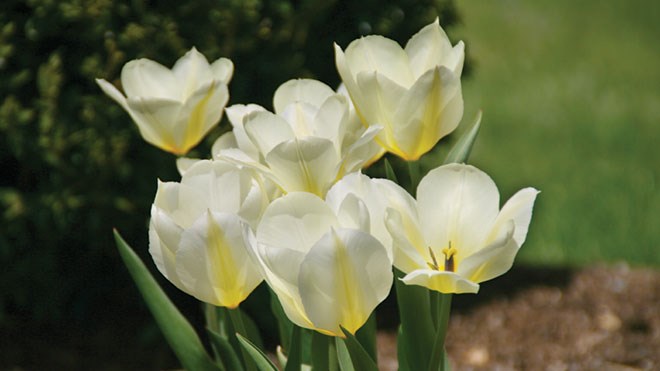Are there flowers more welcome than tulips in spring? These glorious flowers are filled with the hope and promise of wonderful things to come. That alone is why I love them. Of course my Dutch background is most definitely a factor in my love of all tulips.
Tulips have an interesting history. The name “tulip” comes from the Latin tulipa. The shape of the blossom was thought to be similar to the shape of the turban. Turks cultivated the flowers as early as 1000 AD.
The tulip was introduced to Holland in the mid-1500s. The first person to plant tulips in the Netherlands was the head botanist at the University of Leiden, Carolus Clusius, in 1593. The Dutch immediately loved the tulips. Immense sums were paid for a single bulb. A father might offer some tulip bulbs as a dowry for his daughter.
The importance of tulips to Holland cannot be over-emphasized. Just after the Second World War, many tulip bulbs were eaten to keep from starving. In her autobiography, Audrey Hepburn describes the extent of the hunger that she, her mother and many others suffered, and wrote about crushing bulbs to make bread.
Today tulips are grown commercially in huge fields near the Town of Lisse where the world renowned Keukenhof Gardens are located. More than two billion tulip bulbs are grown annually in the Netherlands for export to countries all over the world.
It is really worth a trip to see the fantastic colourful areas in their prime from mid-April to mid-May. Commercial growers cut off the tulip blossoms to produce more and better bulbs. This can be done manually or today by machines.
The result is gorgeous piles of tulips which entrance photographers.
During the Second World War, members of the Dutch Royal Family fled to Canada for safety. Crown Princess Juliana gave birth to a baby girl they named Margriet while living in Ottawa.
In appreciation for their welcome and hospitality, Queen Wilhelmina sent thousands of tulip bulbs to the City of Ottawa. This practice has continued ever since and in May Ottawa hosts the largest Annual Tulip Festival in North America.
We have gone several times and loved the many areas of the city where the brilliant blossoms are on display.
There are 3,000 varieties of tulips now, and this has added to their attraction. The different varieties produce long, colourful displays in the garden as they bloom at different times.
Man hybrids hardly resemble the tulips we are used to seeing. The bearded and fringed tulips are spectacular, and the vibrant colours of orange, yellow, red, and combinations of red and white and even green and white.
I plant tulips every fall in well-drained soil for spring blooming. In our climate, they must be covered with three inches of mulch or leaves to avoid freezing in our long, cold winters.
For best effect, plant them in groups of uneven numbers. The bulbs contain their first season’s food supply. Fertilizer should be added at planting to foster future growth.
In my experience, the bulbs produce for about four years, and after that, the blossoms are smaller and smaller. That’s when I dig them up and plant new bulbs.
I have found that it is important to cut off the flower heads when the petals begin to droop. Leave the rest of the plant to die naturally, as photosynthesis in the leaves provides the nutrients in the bulbs for the following year.
I love all tulips, but my favourite has always been “White Dream,” which is an ivory colour and grows to a height of 50 centimetres. Its splendid elegance has always enticed me both with the classic lines of the petals and the stature of the stem and long leaves.
Another reason why I love tulips is that they appear very early in the spring. In my flower bed, they are currently up by about two inches, and of course I check their growth every day.
It’s fascinating to watch them develop before my eyes, bringing sensational colours to my garden.
Erna de Burger-Fex is a writer and retired teacher.
Join Sudbury.com+
- Messages
- Post a Listing
- Your Listings
- Your Profile
- Your Subscriptions
- Your Likes
- Your Business
- Support Local News
- Payment History
Sudbury.com+ members
Already a +member?
Not a +member?
Sign up for a Sudbury.com+ account for instant access to upcoming contests, local offers, auctions and so much more.
